The Impact of Injector Hole Diameter on Spray Behaviour for Butanol-Diesel Blends
Abstract
:1. Introduction
2. Fuel Preparation and Properties
3. Experimental Setup and Procedure
3.1. Spray Test Setup
3.2. Spray Test Conditions
4. Results of Spray Characteristics and Discussion
4.1. Spray Tip Penetration (S)
4.2. Spray Cone Angle (θ)
4.3. Spray Volume
5. Conclusions
- ❖
- The spray images evaluation showed that the spray penetration length was increased with larger hole diameter and high injection pressure. The spray penetration of the B20D80 blend was slightly further than neat diesel because the butanol reduces the viscosity.
- ❖
- The spray penetration of the test fuel blends becomes longer while the spray cone angle was slightly widened via the increase in either injection pressure or hole diameter.
- ❖
- The spray volume of all the test fuels was increased as a result of increased hole diameter or injection pressures, which results in increased contact surface area between air and fuel, thereby resulting in increased mixing rate and combustion efficiency.
Author Contributions
Acknowledgments
Conflicts of Interest
References
- Algayyim, S.J.M.; Wandel, A.P.; Yusaf, T.; Hamawand, I. The impact of n-butanol and iso-butanol as components of butanol-acetone (BA) mixture-diesel blend on spray, combustion characteristics, engine performance and emission in direct injection diesel engine. Energy 2017, 140 Pt 1, 1074–1086. [Google Scholar] [CrossRef]
- Algayyim, S.J.M.; Wandel, A.P.; Yusaf, T.; Hamawand, I. Production and application of ABE as a biofuel. Renew. Sustain. Energy Rev. 2018, 82 Pt 1, 1195–1214. [Google Scholar] [CrossRef]
- Algayyim, S.J.M.; Wandel, A.P.; Yusaf, T.; Al-Lwayzy, S.; Hamawand, I. Impact of butanol-acetone mixture as a fuel additive on diesel engine performance and emissions. Fuel 2018, 227, 118–126. [Google Scholar] [CrossRef]
- Algayyim, S.J.M.; Wandel, A.P.; Yusaf, T.; Hamawand, I.; AL-Lwayzy, S. The Experimental Investigation of Butanol-Diesel Blend on Engine Performance and Emission Levels in DI Diesel Engine. In Proceedings of the 1st MoHESR and HCED Iraq Scholars Conference in Australasia 2017 (ISCA 2017), Melbourne, Australia, 5–6 December 2017; Swinburne University: Melbourne, Australia, 2017. [Google Scholar]
- Algayyim, S.J.M.; Wandel, A.P.; Yusaf, T. The effect of Butanol-Acetone Mixture-Cottonseed Biodiesel Blend on Spray Characteristics, Engine Performance and Emissions in Diesel Engine. In Proceedings of the 11th Asia-Pacific Conference on Combustion, Sydney, Australia, 10–14 December 2017; The University of Sydney: Sydney, Australia, 2017. [Google Scholar]
- Zaharin, M.S.M.; Abdullah, N.R.; Najafi, G.; Sharudin, H.; Yusaf, T. Effects of physicochemical properties of biodiesel fuel blends with alcohol on diesel engine performance and exhaust emissions: A review. Renew. Sustain. Energy Rev. 2017, 79, 475–493. [Google Scholar] [CrossRef]
- Emiroğlu, A.O.; Şen, M. Combustion, performance and emission characteristics of various alcohol blends in a single cylinder diesel engine. Fuel 2018, 212, 34–40. [Google Scholar] [CrossRef]
- Algayyim, S.J.M.; Wandel, A.P.; Yusaf, T. Experimental and Numerical Investigation of Spray Characteristics of Butanol-Diesel blends. In Proceedings of the 11th Asia-Pacific Conference on Combustion, Sydney, Australia, 10–14 December 2017; The University of Sydney: Sydney, Australia, 2017. [Google Scholar]
- Shuai, C.; Shen, L.; Jiao, L.; Wu, Y.; Tan, Y. Identifying key impact factors on carbon emission: Evidences from panel and time-series data of 125 countries from 1990 to 2011. Appl. Energy 2017, 187, 310–325. [Google Scholar] [CrossRef]
- Algayyim, S.J.M.; Wandel, A.; Yusaf, T.; Hamawand, I.; Al-Lwayzy, S. Experimental Study of Spray Characteristics, Engine Performance and Emission Levels of Acetone-Butanol-Ethanol Mixture-Diesel Blends in a Diesel Engine. In Proceedings of the 11th Asia-Pacific Conference on Combustion, Sydney, Australia, 10–14 December 2017; The University of Sydney: Sydney, Australia, 2017. [Google Scholar]
- Lee, S.; Lee, C.S.; Park, S.; Gupta, J.G.; Maurya, R.K.; Agarwal, A.K. Spray characteristics, engine performance and emissions analysis for Karanja biodiesel and its blends. Energy 2017, 119, 138–151. [Google Scholar] [CrossRef]
- Dong, P.; Yamauchi, J.; Nishida, K.; Ogata, Y. Hole Geometrical Effect on Internal Flow, Fuel Atomization and Spray Evaporation of Multi-Hole Nozzle for Diesel Engine; SAE Technical Paper; SAE International: Warrendale, PA, USA, 2017. [Google Scholar]
- Suh, H.K.; Lee, C.S. A review on atomization and exhaust emissions of a biodiesel-fueled compression ignition engine. Renew. Sustain. Energy Rev. 2016, 58, 1601–1620. [Google Scholar] [CrossRef]
- Soid, S.N.; Zainal, Z.A. Spray and combustion characterization for internal combustion engines using optical measuring techniques, A review. Energy 2011, 36, 724–741. [Google Scholar] [CrossRef]
- Merola, S.S.; Marchitto, L.; Corcione, F.; Valentino, G.; Tornatore, C. Optical diagnostics of the pollutant formation in a CI engine operating with diesel fuel blends. SAE Int. J. Engines 2011, 4, 2543–2558. [Google Scholar] [CrossRef]
- Huo, M.; Lin, S.; Liu, H.; Lee, C.-F.F. Study on the spray and combustion characteristics of water–emulsified diesel. Fuel 2014, 123, 218–229. [Google Scholar] [CrossRef]
- Sazhin, S.S.; Feng, G.; Heikal, M.R. A model for fuel spray penetration. Fuel 2001, 80, 2171–2180. [Google Scholar] [CrossRef]
- Wang, Z.; Wu, S.; Huang, Y.; Chen, Y.; Shi, S.; Cheng, X.; Huang, R. Evaporation and Ignition Characteristics of Water Emulsified Diesel under Conventional and Low Temperature Combustion Conditions. Energies 2017, 10, 1109. [Google Scholar] [CrossRef]
- Zhang, X.; Li, T.; Ma, P.; Wang, B. Spray Combustion Characteristics and Soot Emission Reduction of Hydrous Ethanol Diesel Emulsion Fuel Using Color-Ratio Pyrometry. Energies 2017, 10, 2062. [Google Scholar] [CrossRef]
- Verma, I.; Bish, E.; Kuntz, M.; Meeks, E.; Puduppakkam, K.; Naik, C.; Liang, L. CFD Modeling of Spark Ignited Gasoline Engines—Part 2: Modeling the Engine in Direct Injection Mode along with Spray Validation; No. 2016-01-0579; SAE Technical Paper: Warrendale, PA, USA, 2016. [Google Scholar]
- Gupta, J.G.; Agarwal, A.K. Macroscopic and Microscopic Spray Characteristics of Diesel and Karanja Biodiesel Blends; No. 2016-01-0869; SAE Technical Paper: Warrendale, PA, USA, 2016. [Google Scholar] [CrossRef]
- Todd, D.F.; Scott, E.P. Spray measurement technology: A review. Meas. Sci. Technol. 2015, 26, 012002. [Google Scholar]
- Linne, M. Imaging in the optically dense regions of a spray: A review of developing techniques. Prog. Energy Combust. Sci. 2013, 39, 403–440. [Google Scholar] [CrossRef]
- Chen, P.-C.; Wang, W.-C.; Roberts, W.L.; Fang, T. Spray and atomization of diesel fuel and its alternatives from a single-hole injector using a common rail fuel injection system. Fuel 2013, 103, 850–861. [Google Scholar] [CrossRef]
- Ge, J.C.; Yoon, S.K.; Choi, N.J. Using Canola Oil Biodiesel as an Alternative Fuel in Diesel Engines: A Review. Appl. Sci. 2017, 7, 881. [Google Scholar] [CrossRef]
- Kandasamy, M.; Hamawand, I.; Bowtell, L.; Seneweera, S.; Chakrabarty, S.; Yusaf, T.; Shakoor, Z.; Algayyim, S.J.M.; Eberhard, F. Investigation of Ethanol Production Potential from Lignocellulosic Material without Enzymatic Hydrolysis Using the Ultrasound Technique. Energies 2017, 10, 62. [Google Scholar] [CrossRef]
- Trindade, W.R.D.S.; Santos, R.G.D. Review on the characteristics of butanol, its production and use as fuel in internal combustion engines. Renew. Sustain. Energy Rev. 2017, 69, 642–651. [Google Scholar] [CrossRef]
- Rajesh Kumar, B.; Saravanan, S.; Rana, D.; Nagendran, A. A comparative analysis on combustion and emissions of some next generation higher-alcohol/diesel blends in a direct-injection diesel engine. Energy Convers. Manag. 2016, 119, 246–256. [Google Scholar] [CrossRef]
- Armas, O.; García-Contreras, R.; Ramos, Á. Pollutant emissions from New European Driving Cycle with ethanol and butanol diesel blends. Fuel Process. Technol. 2014, 122, 64–71. [Google Scholar] [CrossRef]
- Karabektas, M.; Hosoz, M. Performance and emission characteristics of a diesel engine using isobutanol–diesel fuel blends. Renew. Energy 2009, 34, 1554–1559. [Google Scholar] [CrossRef]
- Doğan, O. The influence of n-butanol/diesel fuel blends utilization on a small diesel engine performance and emissions. Fuel 2011, 90, 2467–2472. [Google Scholar] [CrossRef]
- Yao, M.; Wang, H.; Zheng, Z.; Yue, Y. Experimental study of n-butanol additive and multi-injection on HD diesel engine performance and emissions. Fuel 2010, 89, 2191–2201. [Google Scholar] [CrossRef]
- Dobre, A.; Pană, C.; Nuţu, N.; Negurescu, N.; Cernat, A.; Bondoc, I. Bio-butanol-alternative fuel for Diesel engine. INMATEH-Agric. Eng. 2014, 42, 145–152. [Google Scholar]
- Li, Q.; Jin, W.; Huang, Z. Laminar Flame Characteristics of C1–C5 Primary Alcohol-Isooctane Blends at Elevated Temperature. Energies 2016, 9, 511. [Google Scholar] [CrossRef]
- Liu, H.; Lee, C.; Huo, M.; Yao, M. Comparison of ethanol and butanol as additives in soybean biodiesel using a constant volume combustion chamber. Energy Fuels 2011, 25, 1837–1846. [Google Scholar] [CrossRef]
- Wu, H.; Nithyanandan, K.; Lee, T.H.; Lee, C.-F.F.; Zhang, C. Spray and combustion characteristics of neat acetone-butanol-ethanol, n-butanol, and diesel in a constant volume chamber. Energy Fuels 2014, 28, 6380–6391. [Google Scholar] [CrossRef]
- Rao, D.C.K.; Karmakar, S.; Som, S.K. Puffing and Micro-Explosion Behavior in Combustion of Butanol/Jet A-1 and Acetone-Butanol-Ethanol (A-B-E)/Jet A-1 Fuel Droplets. Combust. Sci. Technol. 2017, 189, 1796–1812. [Google Scholar] [CrossRef]
- Lešnik, L.; Vajda, B.; Žunič, Z.; Škerget, L.; Kegl, B. The influence of biodiesel fuel on injection characteristics, diesel engine performance, and emission formation. Appl. Energy 2013, 111, 558–570. [Google Scholar] [CrossRef]
- Kang, S.; Cho, W.; Bae, C.; Kim, Y. Influence of the Injector Geometry at 250 MPa Injection in a Light-Duty Diesel Engine; SAE International: Warrendale, PA, USA, 2017. [Google Scholar]
- Payri, R.; Salvador, F.J.; De la Morena, J.; Pagano, V. Experimental investigation of the effect of orifices inclination angle in multihole diesel injector nozzles. Part 2—Spray characteristics. Fuel 2018, 213, 215–221. [Google Scholar] [CrossRef]
- Moon, S.; Gao, Y.; Park, S.; Wang, J.; Kurimoto, N.; Nishijima, Y. Effect of the number and position of nozzle holes on in-and near-nozzle dynamic characteristics of diesel injection. Fuel 2015, 150, 112–122. [Google Scholar] [CrossRef]
- Mulemane, A.; Han, J.-S.; Lu, P.-H.; Yoon, S.-J.; Lai, M.-C. Modeling Dynamic Behavior of Diesel Fuel Injection Systems; No. 2004-01-0536; SAE Technical Paper: Warrendale, PA, USA, 2004. [Google Scholar] [CrossRef]
- Lai, M.-C.; Wang, T.C.T.; Xie, X.; Han, J.-S.; Henein, N.; Schwarz, E.; Bryzik, W. Microscopic Characterization of Diesel Sprays at VCO Nozzle Exit; No. 982542; SAE Technical Paper: Warrendale, PA, USA, 1998. [Google Scholar] [CrossRef]
- Kuti, O.A.; Zhu, J.; Nishida, K.; Wang, X.; Huang, Z. Characterization of spray and combustion processes of biodiesel fuel injected by diesel engine common rail system. Fuel 2013, 104, 838–846. [Google Scholar] [CrossRef]
- Delacourt, E.; Desmet, B.; Besson, B. Characterisation of very high pressure diesel sprays using digital imaging techniques. Fuel 2005, 84, 859–867. [Google Scholar] [CrossRef]
- Yu, W.; Yang, W.; Mohan, B.; Tay, K.L.; Zhao, F. Macroscopic spray characteristics of wide distillation fuel (WDF). Appl. Energy 2017, 185, 1372–1382. [Google Scholar] [CrossRef]
- Yu, W.; Yang, W.; Tay, K.; Mohan, B.; Zhao, F.; Zhang, Y. Macroscopic spray characteristics of kerosene and diesel based on two different piezoelectric and solenoid injectors. Exp. Therm. Fluid Sci. 2016, 76, 12–23. [Google Scholar] [CrossRef]
- Wang, X.; Huang, Z.; Kuti, O.A.; Zhang, W.; Nishida, K. Experimental and analytical study on biodiesel and diesel spray characteristics under ultra-high injection pressure. Int. J. Heat Fluid Flow 2010, 31, 659–666. [Google Scholar] [CrossRef]
- Heywood, J.B. Internal Combustion Engine Fundamentals; McGraw-Hill: New York, NY, USA, 1988. [Google Scholar]
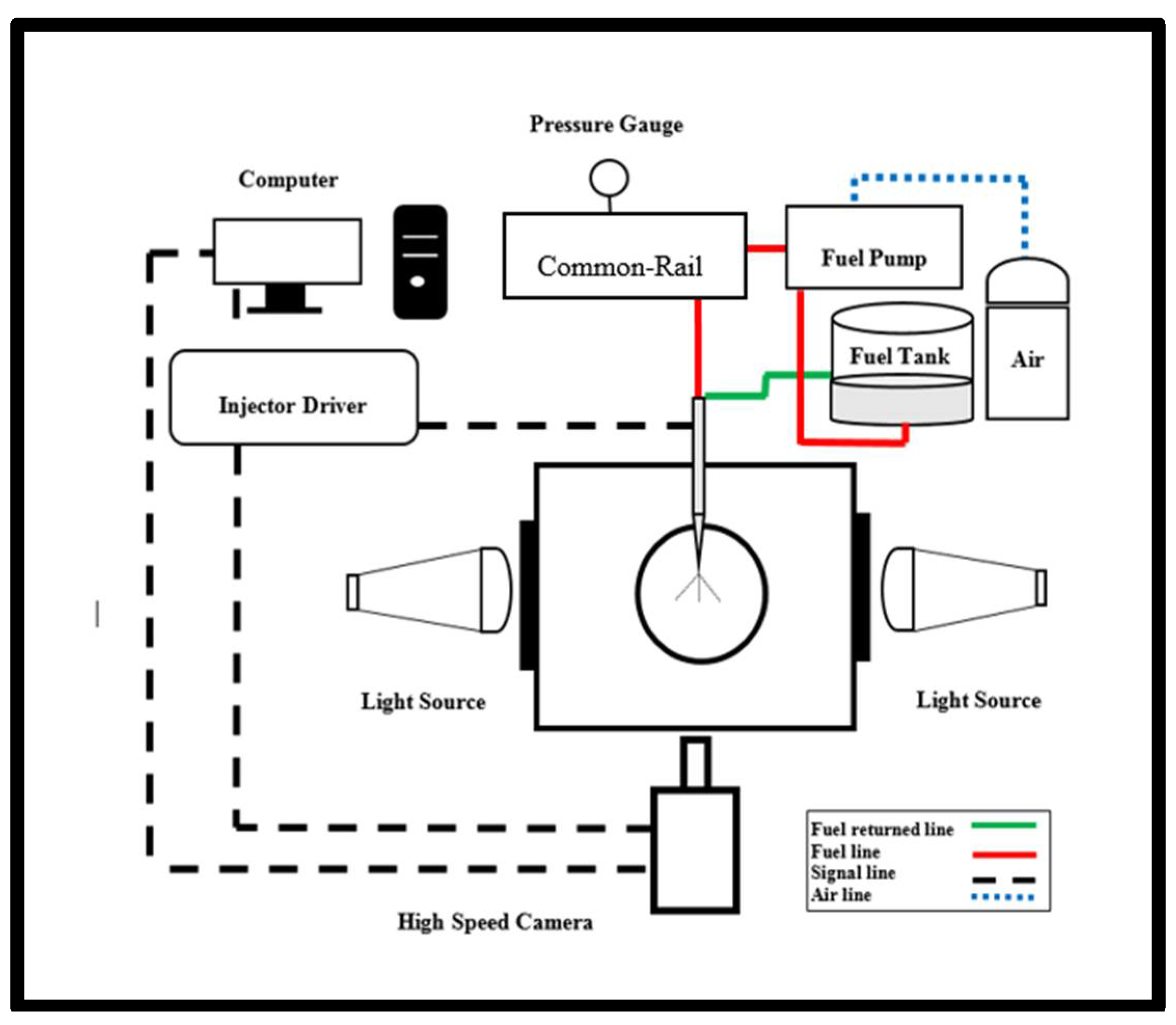
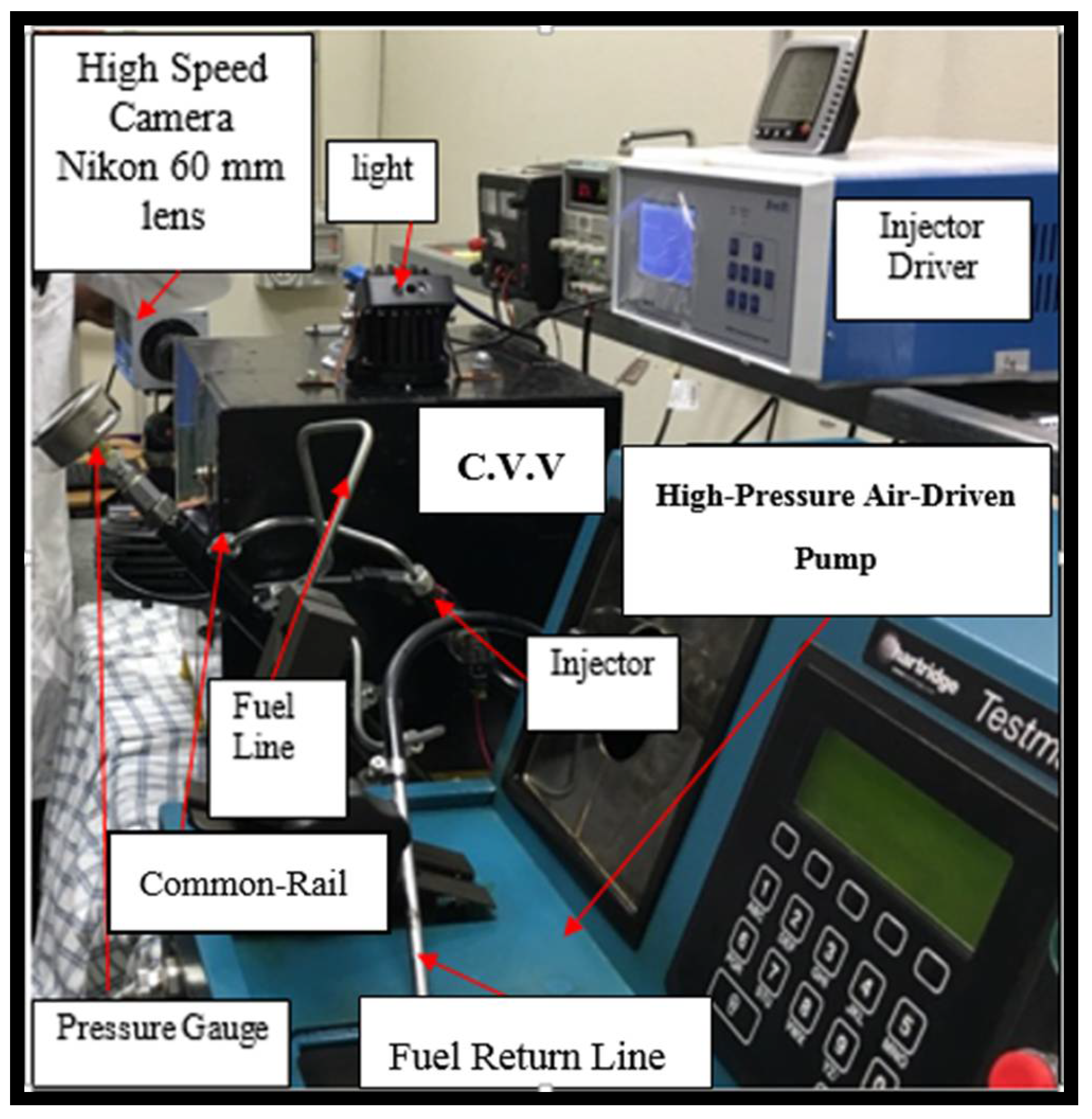
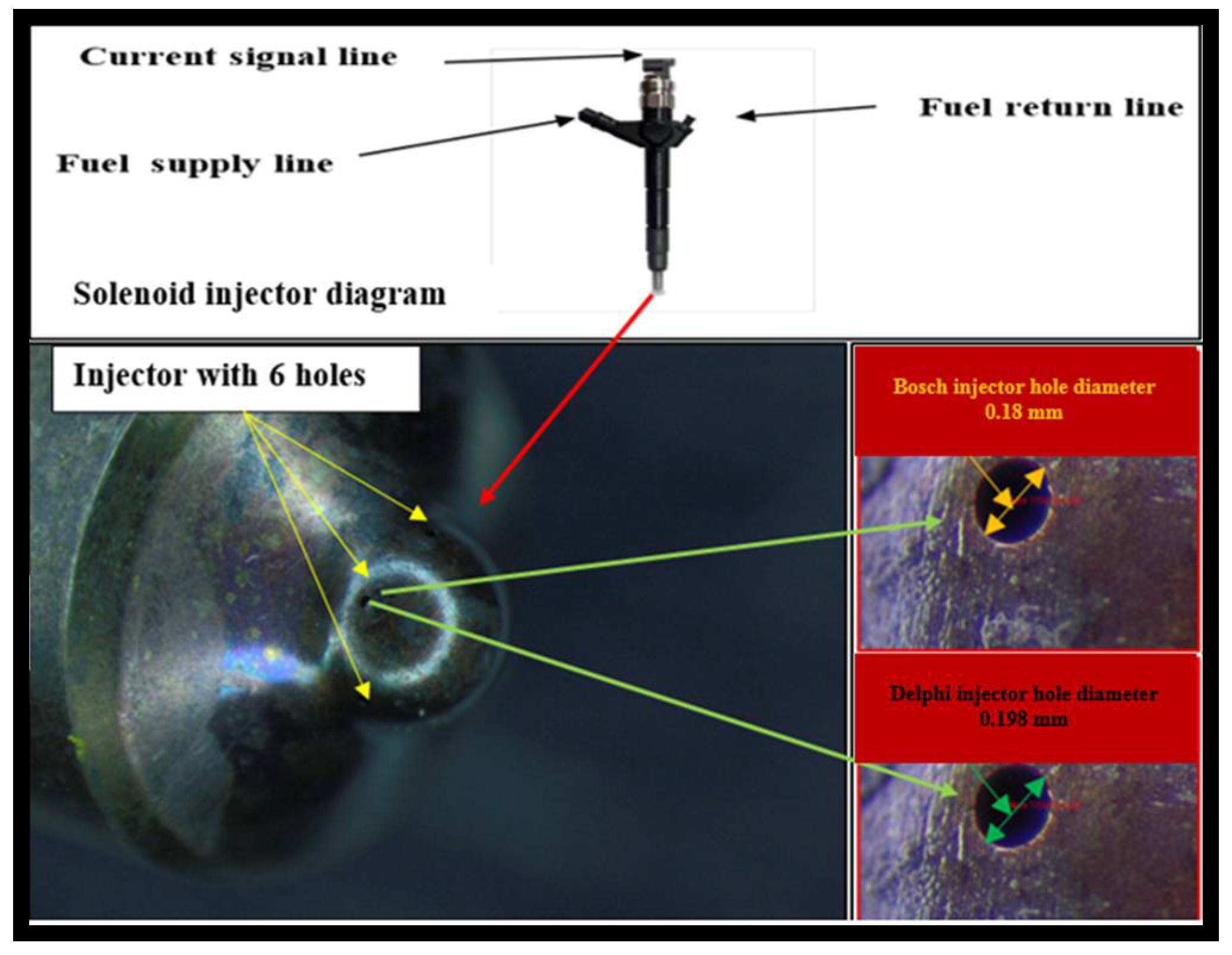

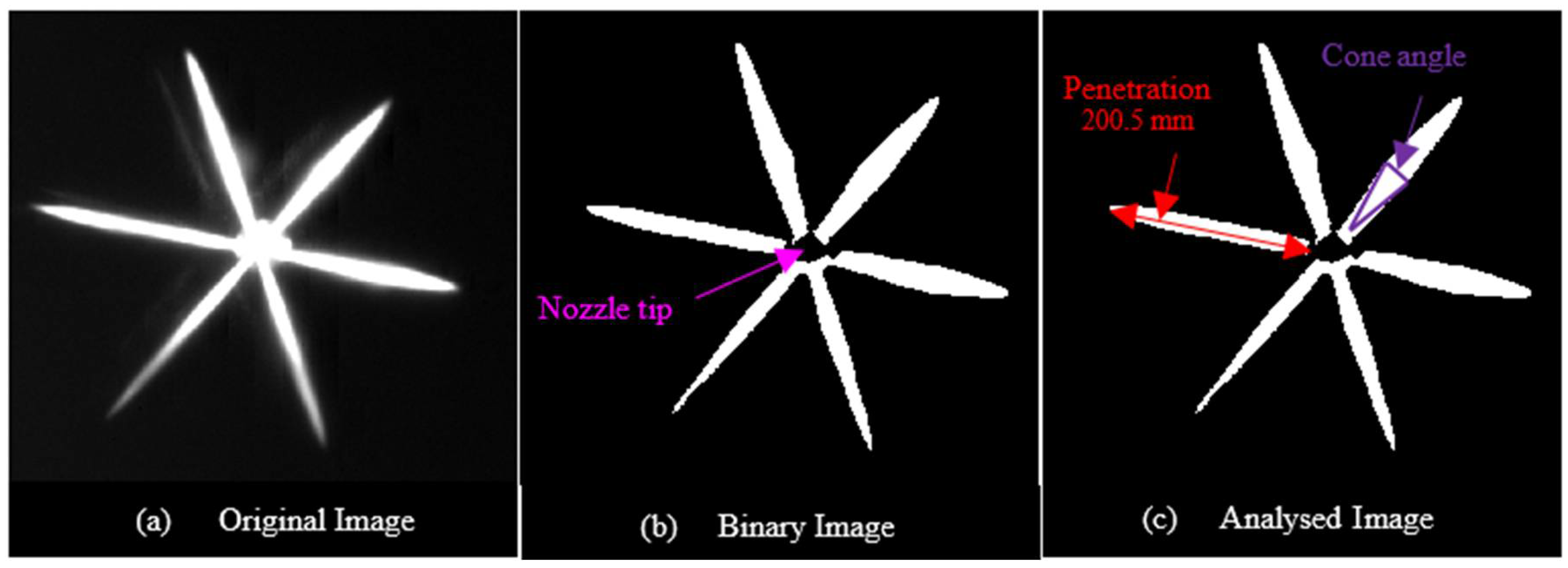
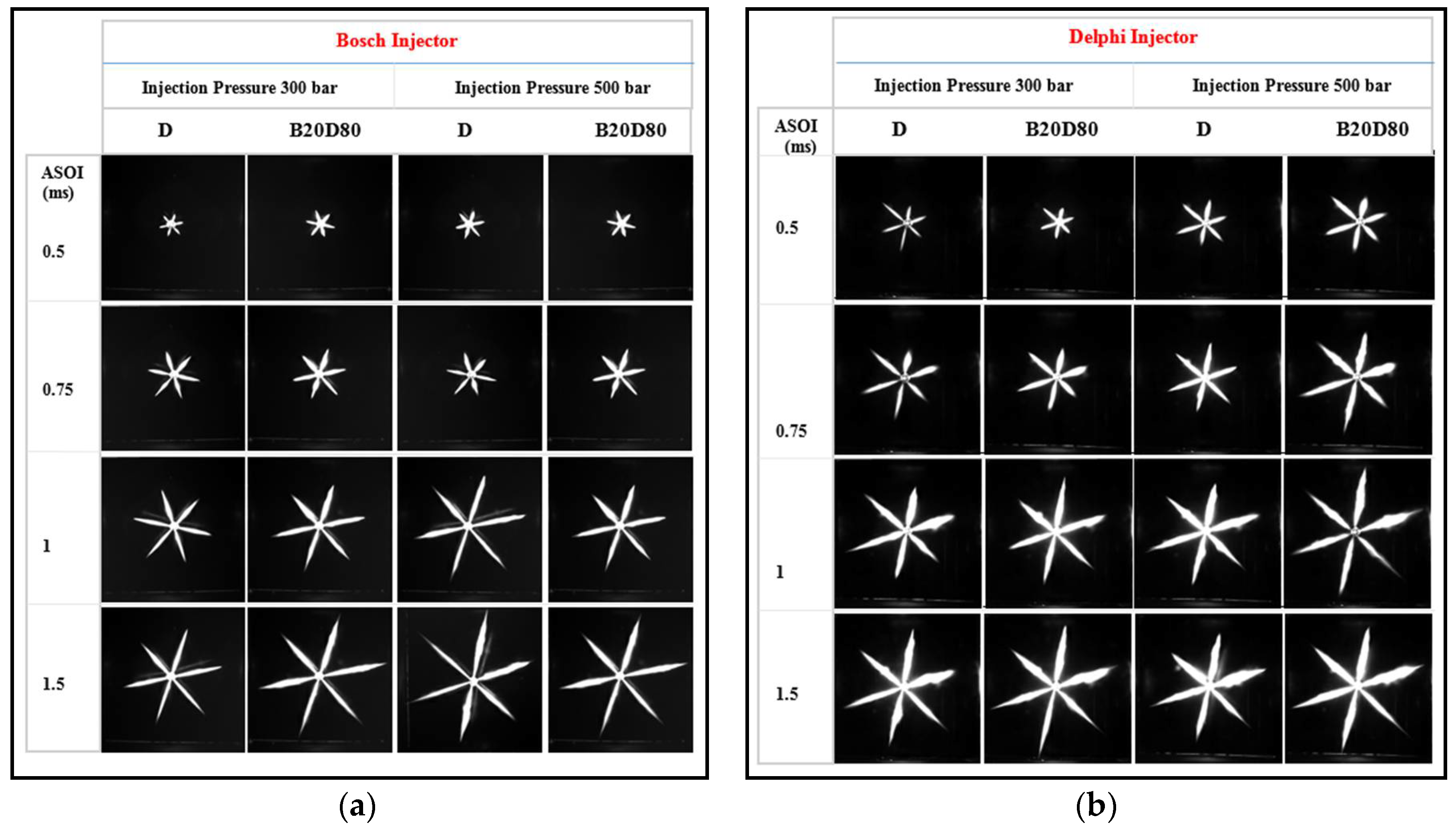

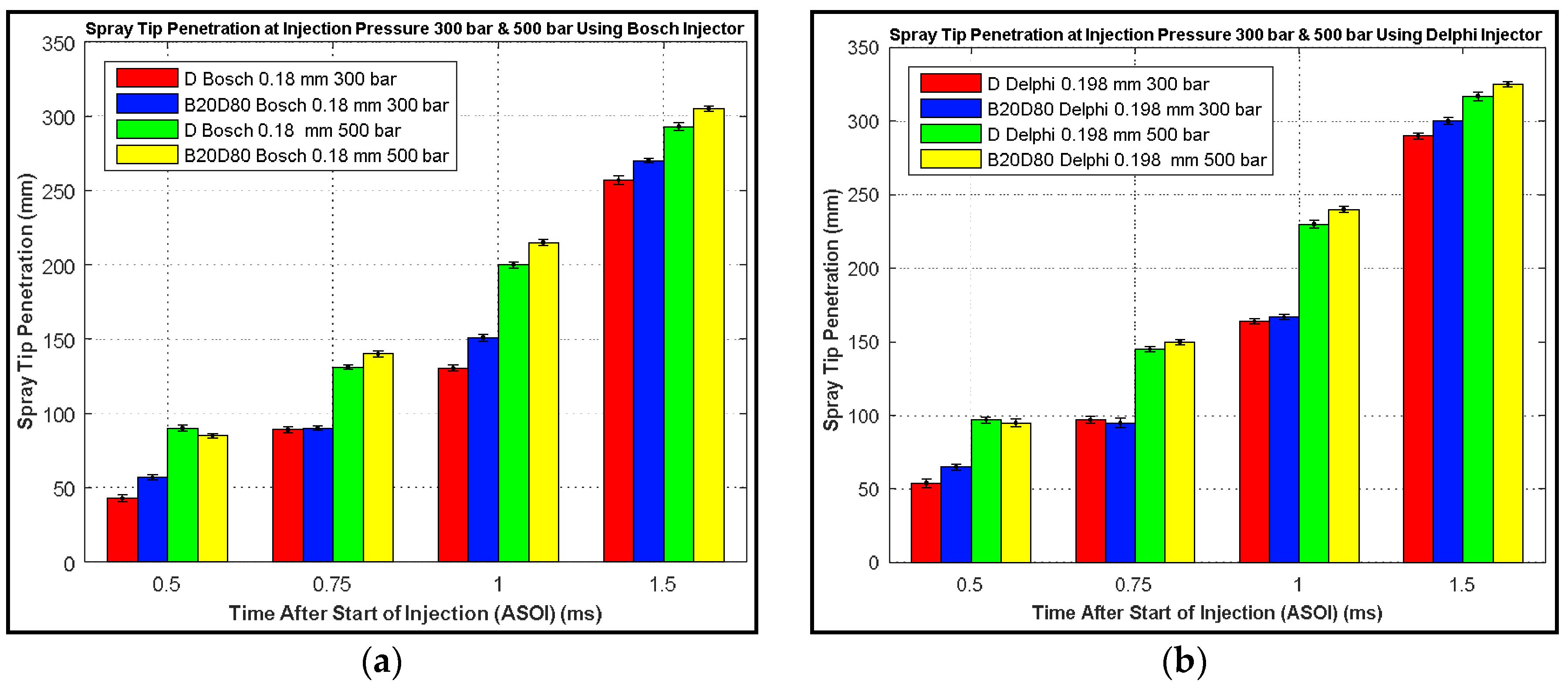
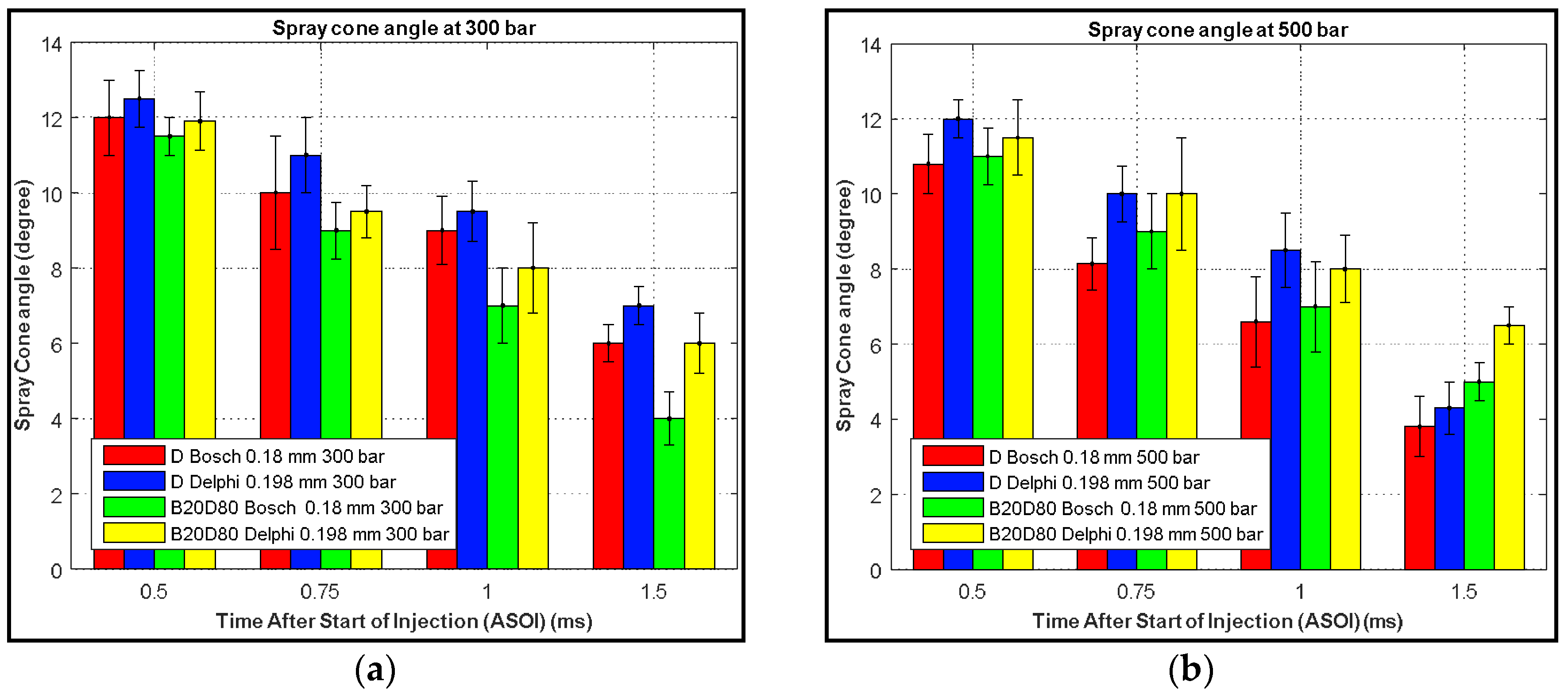
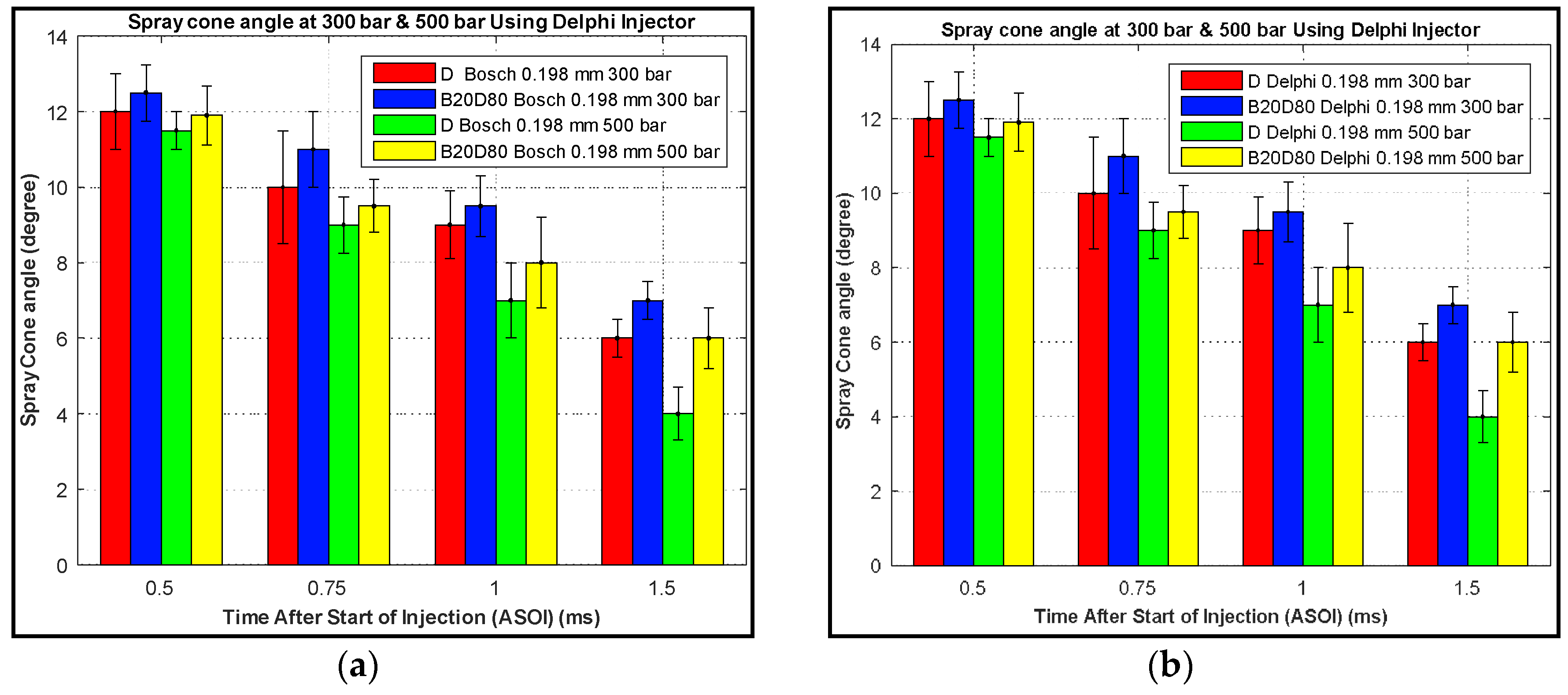
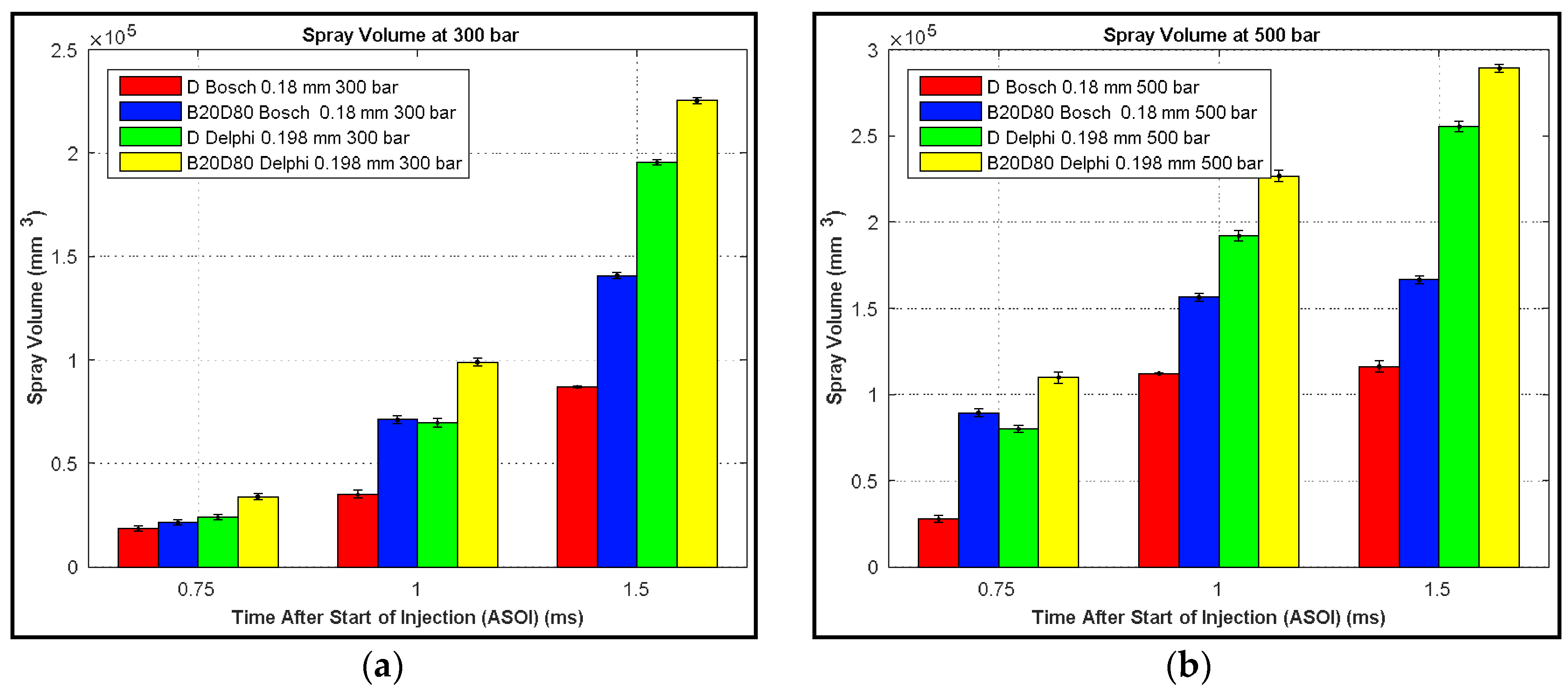
| Properties | Diesel (D) | Butanol (B) | B20D80 |
|---|---|---|---|
| Chemical formula | C12–C25 | C4H9OH | - |
| Composition (C, H, O) (mass %) | - | 65, 13.5, 21.5 | - |
| Density (kg/L) | 0.86 a | 0.810 b | 0.825 a |
| Viscosity (mm2/s) at 40 °C | 2.46 a | 2.2 b | 2.25 a |
| Calorific value (MJ/kg) | 42.65 a | 33.1 b | 41.17 a |
| Surface tension (mN/m) | 23.8 b | 24.2 b | - |
| Cetane number | 48 b | 17–25 b | - |
| Latent heat of vaporisation (kJ/kg) | 270 b | 582 b | - |
| Boiling point (°C) | 200–400 b | 118 b | - |
| Flash point (°C) | 74 b | 35 b | - |
| Injector Make/Type | |
| Injector type | Bosch electromagnetic common rail solenoid injector (hole diameter 0.18 mm) |
| Delphi electromagnetic common rail solenoid injector (hole diameter 0.198 mm) | |
| Injection enclosed angle | 156° |
| Number of injector holes | 6 |
| Injection quantity | 12 mg |
| Camera Specification and Filter | |
| Camera resolution at frame rate | 1024 × 1024 pixels at 2000 fps |
| Filter size | 62 mm |
| Injection Setup | |
| Injection pressure | 300 & 500 bar |
| After start of injection time (ASOI) | 0.5, 0.75, 1 and 1.5 ms |
| Fuel temperature | 21.5 °C |
| Room temperature | 22.8 °C |
© 2018 by the authors. Licensee MDPI, Basel, Switzerland. This article is an open access article distributed under the terms and conditions of the Creative Commons Attribution (CC BY) license (http://creativecommons.org/licenses/by/4.0/).
Share and Cite
Algayyim, S.J.M.; Wandel, A.P.; Yusaf, T. The Impact of Injector Hole Diameter on Spray Behaviour for Butanol-Diesel Blends. Energies 2018, 11, 1298. https://doi.org/10.3390/en11051298
Algayyim SJM, Wandel AP, Yusaf T. The Impact of Injector Hole Diameter on Spray Behaviour for Butanol-Diesel Blends. Energies. 2018; 11(5):1298. https://doi.org/10.3390/en11051298
Chicago/Turabian StyleAlgayyim, Sattar Jabbar Murad, Andrew P. Wandel, and Talal Yusaf. 2018. "The Impact of Injector Hole Diameter on Spray Behaviour for Butanol-Diesel Blends" Energies 11, no. 5: 1298. https://doi.org/10.3390/en11051298
APA StyleAlgayyim, S. J. M., Wandel, A. P., & Yusaf, T. (2018). The Impact of Injector Hole Diameter on Spray Behaviour for Butanol-Diesel Blends. Energies, 11(5), 1298. https://doi.org/10.3390/en11051298







